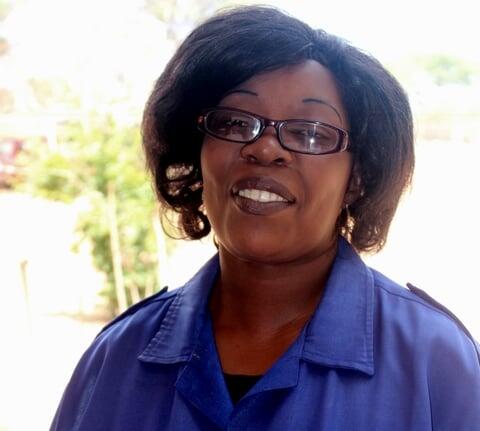Gobabis, Omaheke Region, Namibia — Each day, single mother Elizabeth Kazapua rises at 4.30 a.m. and begins her hour-long journey by foot to work at the site of a ground-breaking pilot project at Epako Clinic in Gobabis, Namibia. Here, she makes sure that those who are very sick, the elderly and pregnant women are treated first.
If not for her uniform, she could easily be mistaken as a nurse. This is because Ms. Kazapua goes beyond her duty as a security guard to ensure that patients are safe and lined up in an orderly manner.
“I love it here. Every shift I feel motivated,” she says as she directs a young lady to the pharmacy.
Some of them she knows by name, particularly those who have chronic conditions.
A model site for health services
Epako Clinic is a model site for health service provision – but this wasn’t always so. For years, just like many other health facilities in Namibia, the clinic’s door labels were an indirect source of HIV-related stigma.
Distinct rooms were set aside for the care of HIV patients, and this compromised HIV-positive patients’ confidentiality as they could easily be identified by others when accessing these rooms. The result was that many HIV patients shied away from accessing the services they needed.
The fragmentation of health services arose with the emergence of the HIV & AIDs pandemic in the mid-80s, which led to increased donor funding for responding to HIV. As a result, HIV and sexual and reproductive health (SRH) services were provided in silos. To address these challenges – and many other inefficiencies experienced by health facilities in the country – UNFPA, the United Nations Population Fund with the Joint United Nations Programme on HIV/AIDS (UNAIDS) is implementing the Sexual and Reproductive Health and Rights (SRHR) and HIV Linkages in East and Southern Africa project in seven facilities across four regions of the country.
This is in partnership with the Namibian Government's Ministry of Health and Social Services. Funding for the project has been provided by the European Union (EU) and the Swedish International Development Cooperation Agency (Sida).
Why integrated services are critical to HIV prevention
Integrating SHR and HIV services is an important strategy to prevent not only HIV, but other sexually transmitted infections and unintended pregnancies. It also minimizes missed opportunities for addressing the SRH needs of people living with HIV.
Namibia has a mature HIV epidemic, with an estimated HIV prevalence of 14 per cent. Key challenges in the health sector include poor maternal mortality and sexual and reproductive health indicators.
The country’s maternal mortality ratio (MMR) is currently estimated at 130 deaths per 100,000 live births, while 18 per cent of pregnant women attending the country’s antenatal clinics are living with HIV.
Success leads to scale-up
By organizing health services using the ‘one nurse, one patient, one room’ model—as in the case of Epako Clinic—the uptake of critical SRH and HIV services by the community has increased. For example, the number of first-time family planning visits increased by almost 15 per cent. In most cases, first-time family planning is accessed by adolescents and young girls.
“The good thing about this model of integration is that people are assigned to rooms, which reduces the waiting hours.
Even if the queue is long, people don’t need to wait that long,” Ms. Kazapua says. Improvements in nurse productivity and waiting time at health facilities have also been noted. Nurse productivity improved from 0.9 patients per nurse, per hour to 1.94 patients/nurse/hour, an increase in productivity of 54 per cent. The new model has also seen waiting times reduce from about five hours to three hours. Another improvement has been provider–client communication, as patients are able to communicate in their vernacular language and minimized stigma.
The accomplishments of this model have reinforced political commitment. Namibia’s Ministry of Health and Social Services has pledged to scale up the model to 73 health facilities in 2017.
At Epako Clinic, the change for the better is clearly evident.
“I am also glad patients are no longer alienated according to what they suffer from. This integration process makes my job easier,” Ms. Kazapua says with a smile. By Emma Mbekele


